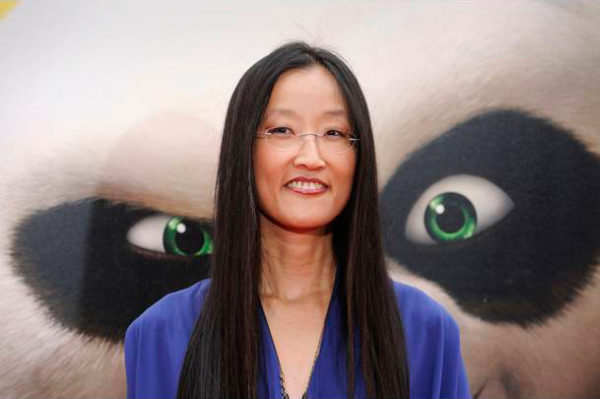Creative Screenwriting Magazine had the opportunity to talk shop with writer-director Jennifer Yuh Nelson, who is most famously known for her work on the animated Kung Fu Panda movies. She discusses her creative process and her shift from animated features to her latest live-action film The Darkest Minds.
“Some people say their brain is in their hand. Mine is definitely in my head,” said animator turned director, Jennifer Yuh Nelson. Perhaps best known as the first female solo-director of a Hollywood animated film for Kung Fu Panda 2 and 3, Yuh has recently moved into live action with the young adult film, ‘The Darkest Minds.’
“I have to see [an image] completely done in my head before I know what to draw. Before I put pen to paper, or stylus to screen, I always just walk around for a few hours or even a day to get it completely finished in my head, first. Then it’s like projecting an image on the page or the screen. I trace what’s already done.”
The animator knew she wanted to follow this career at a very early age. She went to school as an Illustrations Major, but she actually drew live action storyboards as a kid. When she decided to learn about filmmaking and storytelling, she reached out to her older sister Gloria, who got her a job as a PA at an animation studio.
“I was a big fan of Anime. I actually didn’t have a lot of exposure to American feature films, specifically because they didn’t play them on TV as often as other things. I didn’t have cable TV or anything like that. So, I watched a lot of Anime. When I was in college, I watched a lot of the weirder stuff,” she joked.
Yuh enjoyed cross-genre animations such as Ghost in the Shell, Akira, and My Neighbor Totoro, which didn’t exactly cater to children like most other animations.

Animated Hand-to-Hand Combat
At Dreamworks, the Kung Fu Panda franchise all got started with a title on the page. “Back then, the concepts for a lot of these animated films—they would start thinking about an interesting area that maybe hadn’t been explored before,” Yuh said there were countless animal movies at the time, but this was the first martial arts movie.
“When I first came on, there was essentially the title and a very, very early draft. The idea came from the development department. I just basically heard this title Kung Fu Panda and asked to be on in any capacity because I loved the title so much,” she said about the franchise.
“I had always been a fan of action movies and I’ve watched all the Hong Kong action movies. I was a huge fan of all the different kinds of martial arts. To look at me, you wouldn’t think I would be interested in all the different kinds of martial arts around the world, but I am. I think it’s a beautifully, choreographic discipline that also involves biomechanics,” said the director. “It’s a weird thing.”
For this project, specifically, she wanted to be involved with creating action. She enjoyed straight animation, but desperately wanted to work within a medium that combined animation with action.
“They said, ‘What do you want to do?’ I said, ‘Kung Fu Panda. I have to work on this film because I want to work on something with Kung Fu. I want to push the boundaries of what you can do with the camera and what you can do showing martial arts in an animated film. On top of that, it sounded like a funny idea,” she added.
Thanks to her loyalty to the company, they assigned her to the project and then gave her the task of creating a two-and-a-half minute, 2D Anime-style opening as a secondary project for the film. Because of how well she finished this smaller gig, she was later asked to direct Kung Fu Panda 2 and 3 as a solo director.
Jumping Into The Deep End
“I was completely overwhelmed with the idea [of directing] because as the Head Of Story, you’re basically the Special Forces deployed to take care of problems. You don’t necessarily have to stand there and be the final word in a lot of things. You can suggest all you want, but ultimately the blame falls on the director,” said Yuh.
“I had been working on the story for many years, but the thought of being a director was somebody that I wasn’t. I assumed they were a lot louder and room-controlling, and assertively extroverted than I was,” said the self-proclaimed introvert. “Usually, in meetings at work, I would be the one that spoke the least.”
Despite his unobtrusive nature, the others in the room quickly realized that when she did speak, it was for a good reason. “It wasn’t about quantity. It was about quality for me,” joked Yuh. But, Producer Melissa Cobb was the one in her corner pushing her to take on the job as the official director of the next project.
Cobb told Yuh it would be good for her to take on the responsibility and she knew she could do it. “It will be good for you. It will be good for the film,” Cobb told her. Initially, she was still against the idea, but Cobb insisted. The producer even gave her the 2D animation task as a confidence builder, like “training wheels.”
Unlike other films, which may take 1-2 years for a director to complete, an animated feature actually takes around 4 years to complete, from start to finish.

From Animation To Live Action
“I always wanted to do live action,” said Yuh about her latest film, The Darkest Minds. While storyboarding as a kid, she was always thinking about live action rather than animation. “I would literally put a filter in my head to try and figure out how to animate it,” she said. For live action, she had to abandon this preconceived filter.
“For me, the process, in the beginning, was exactly the same. Working with the actors, developing the imagery, all that stuff was literally the same process. The shift came in actual production when we’re out doing the shoot,” said the director.
The Darkest Minds isn’t drastically different than other recent YA-genre films. On the surface, children have superpowers and the government is out to get them. It’s loaded with symbolism, metaphors, and youthful repression. Off paper, however, the film is much more. It’s tangible, packed with emotions, and unique.
The story is also simpler than The Hunger Games or the Divergent series. In the mysterious future, a virus has killed 90 percent of America’s children. The survivors all seem to have mutant-like powers. Some are brilliant. Some control minds. Others have powers that involve electricity. Yuh loved the emotional core in the book and even the first draft of the script.
Finding The Emotional Core
“I love the emotional core of the book. There are a lot of scripts that you read and even in the early iterations of scripts, they may not have that emotional core, but this one did. It existed in the book. It existed in the earliest screenplay. When I read it, I thought, ‘If you have that, you know what you’re shooting for. Every single scene has got to go to that emotional point. I just wanted to see that live…’”
Within the film, Yuh believes “everything serves the one [emotional core.] ” The entire film should head towards this single intersection, or emotional point, which makes the overall story work. Anything that doesn’t serve this point should be taken away. “It’s that pivotal moment where you see people cry or something like that. It’s that peak emotional moment.”
Moving from animation to live action is a drastically different time scale. “It’s so refreshing in live action to get the beginning, middle and end done in about a year. It’s shocking. It’s incredibly liberating. Not only do you have to make decisions quickly, but you see the results quickly, [and] you also get coverage. So you can experiment a lot more with what the footage can say.”
With animation, on the other hand, every single frame has to be pre-planned. When it’s time to edit the animated feature, there’s rarely anything to change. There’s only one angle. There’s only one version of each scene. There aren’t different reactions from different angles. With live action, Yuh likes to “let the happy accidents happen.”
Being Ready For Opportunities
Thanks to Melissa Cobb, early conversations with Guillermo del Toro, and Dreamworks as a whole, Yuh was allowed to thrive in an encouraging environment. Likewise, she encourages people to look for internships where they might get access to people they would not normally meet otherwise. “You get to see how a system runs and you’re only there to be helpful and to be helped.”
In addition, Yuh also said there’s not exactly a linear path to success. “While you’re working on things you may not directly want to do, everything is an opportunity. You’re bombarded by opportunities all the time and it’s a question of being ready to take advantage of those opportunities. I say, ‘Just be ready.’”
“The big thing is to form those mentorships, get those relationships, become very useful so that people will want you around. Then, those opportunities are more likely to happen,” concluded the animator-director.
In terms of advice for women, Yuh often has a tough time finding the explanation as to why she’s the first (and only) female director for an animated film. “I don’t feel like I did anything radically, insanely unusual in order to be a female film director in animation. It baffles me why I would be any different than anyone else, as far as women aspiring to do this job.”
“I think the main reason I am where I am is because I had somebody who supported me. I had people say, ‘You need to do this.’ A lot of the time people think, ‘What do I do as a person who walks in the room and gets the job?’ That’s only half the picture. You have to be incredibly ready when jobs are offered to you,” added Yuh. “Minimize the risk someone is taking. But that someone has to take that risk…”
This article has been condensed. Listen to the full audio interview HERE.
Read our conversation with the Kung Fu Panda screenwriters HERE.

